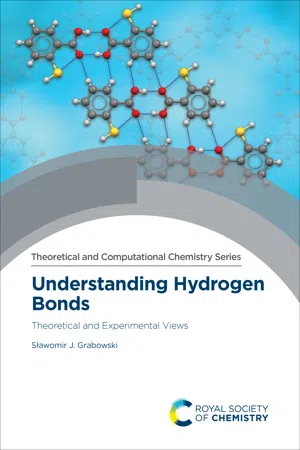![]()
CHAPTER 1
Hydrogen Bond – Definitions, Criteria of Existence and Various Types
1.1Definitions of Hydrogen Bond
It is often controversial who first introduced the term hydrogen bond and which were the first studies on this kind of interaction. It is not discussed and described in detail here because it has been done in former review articles and monographs.1–7 However, it is worth mentioning a few early studies on terms related to the hydrogen bond and on definitions because they are important to understand the descriptions and explanations that appear further in this book. Various statements and explanations mentioned in this chapter show that many ideas and models that have often appeared recently in numerous articles have their roots in very early studies; sometimes such studies come from the beginning of the twentieth century.
It seems that M. L. Huggins was the first to introduce the concept related to the hydrogen bond in a thesis of the advanced inorganic chemistry course at the University of California in 1919.8 This concept was further clarified and applied by W. M. Latimer and W. H. Rodebush in a study on polarity and ionization phenomena that were described in terms of the Lewis theory of valence.9 The authors stated that ‘in terms of the Lewis theory, a free pair of electrons on one water molecule might be able to exert sufficient force on a hydrogen held by a pair of electrons on another water molecule to bind the two molecules together’. Next they explain, ‘Such combination need not be limited to the formation of double or triple molecules. Indeed the liquid may be made up of large aggregates of molecules, continually breaking up and reforming under the influence of thermal agitation. Such an explanation amounts to saying that the hydrogen nucleus held between 2 octets constitutes a weak bond’.9 The latter statement (in italics) may be treated as the first definition of the hydrogen bond, or at least one of the first definitions. Latimer and Rodebush present ammonium hydroxide as an example of such an arrangement and next they show numerous examples of structures existing in liquids and fulfilling the rules of the Lewis model; among them, arrangements which may be classified as hydrogen bonds are discussed.9 One can see that numerous topics early discussed by Latimer and Rodebush are analysed further in various studies; not only is the hydrogen bond interaction a subject of such further studies but also cooperativity effects, thermal motions in water, Lewis structures of various species, etc. It is important that the authors also stated in their article that ‘Mr. Huggins of this laboratory in some work as yet unpublished, has used the idea of a hydrogen kernel held between two atoms as a theory in regard to certain organic compounds’.9
G. A. Jeffrey has written that in the first studies on the hydrogen bond interaction the term ‘hydrogen bond’ was not used8 and that it was used for the first time probably by Pauling in 1931.10 However, one can find that G. N. Lewis referred to the above-mentioned study of Latimer and Rodebush, as he wrote in his monograph in 1923: ‘It seems to me that the most important addition to my theory of valence lies in the suggestion of what has become known as the hydrogen bond. The idea first suggested by Dr. M. L. Huggins and advanced by Latimer and Rodebush is that an atom of hydrogen may at times be attached to two electron pairs of two different atoms, thus acting as a loose bond between these atoms.’11 Thus, Lewis was probably the first to intro...
